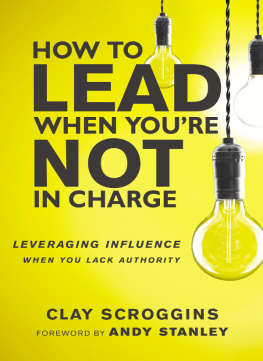Gerald M. Czarnecki - Youre in Charge...What Now?
Here you can read online Gerald M. Czarnecki - Youre in Charge...What Now? full text of the book (entire story) in english for free. Download pdf and epub, get meaning, cover and reviews about this ebook. genre: Business. Description of the work, (preface) as well as reviews are available. Best literature library LitArk.com created for fans of good reading and offers a wide selection of genres:
Romance novel
Science fiction
Adventure
Detective
Science
History
Home and family
Prose
Art
Politics
Computer
Non-fiction
Religion
Business
Children
Humor
Choose a favorite category and find really read worthwhile books. Enjoy immersion in the world of imagination, feel the emotions of the characters or learn something new for yourself, make an fascinating discovery.

- Book:Youre in Charge...What Now?
- Author:
- Genre:
- Rating:3 / 5
- Favourites:Add to favourites
- Your mark:
- 60
- 1
- 2
- 3
- 4
- 5
Youre in Charge...What Now?: summary, description and annotation
We offer to read an annotation, description, summary or preface (depends on what the author of the book "Youre in Charge...What Now?" wrote himself). If you haven't found the necessary information about the book — write in the comments, we will try to find it.
Youre in Charge...What Now? — read online for free the complete book (whole text) full work
Below is the text of the book, divided by pages. System saving the place of the last page read, allows you to conveniently read the book "Youre in Charge...What Now?" online for free, without having to search again every time where you left off. Put a bookmark, and you can go to the page where you finished reading at any time.
Font size:
Interval:
Bookmark:


CONTENTS
To the memory of my parents, Elizabeth and Wallace Neff.
TJN
To Patty and George Sarner, the worlds best in-laws, for their eternal love and support.
JMC
INTRODUCTION
Recently our friend Matt Mannelly was sitting at the Dunkin Donuts in New Canaan, Connecticut, jotting some notes on a piece of paper. Standing on line, we wondered how his job search was going. When we sat down at Matts table, he gave us the wonderful news that he had just closed a deal late the previous night to become president of Cannondale Bicycles.
After well-deserved congratulations, we asked when he would be starting. In two hours, he replied.
Given that Matt was jumping into his new role with almost no time to prepare, he was happy to hear about our three-year research project studying a hundred of the best and worst leadership transitions and the key lessons about how to get off to the right start. While he intuitively knew that he had a unique window of opportunity to make a positive first impression later that morning, Matt had not developed a precise plan for what he was going to do when he showed up. We suggested that he consider such fundamental questions as:
Who are you going to meet with first, and what are you going to say?
How is your appointment being announced internally and externally?
Have you prepared a formal presentation for employees and the management team?
Did you review your day and meeting agenda with the board?
These kinds of details are often overlooked, creating the impression that you are disorganized or out of sync with the person who hired you. We also pointed out to Matt that while he is going to be focused on getting his message out, the managers he meets are likely going to be seeing and hearing something altogether different. They will be sizing up your every word, move, and expression to see if they will grant you their respect, we told him. And they will be thinking, Will this new president be good or bad for me? We also suggested that in his earliest conversations and communications, he should find a way to share the reasons why he took the job, his own personal and professional background, his expectations of the management team and employees, and potentially an assessment of the companys competitive positioning, as well as initial thoughts about a vision for the future. These were just some of the questions and issues he had to be ready for on his first day.
Matt had in fact thought about many of them, but he had not focused at all on some of the others. There were at least two potential traps into which he had been heading unaware before our conversation. So with the help of coffee and doughnuts we spent the next hour sharing highlights of what many of the most prominent business leaders did that resulted in the very best and worst leadership transitions. One we talked about in detail was Paul Pressler.
There was a lot of apprehension on September 26, 2002, when Gap Inc. announced that Paul S. Pressler, chairman of Walt Disney Parks and Resorts, would become the companys new chief executive. People were asking, Who is this guy? What does he know about retail, fashion, and apparel? What will he do when he shows up?
Pressler had a major challenge as CEO, and he was committed to getting off to the right start so he could lay the foundation for the companys long-term success. The worlds largest specialty-apparel retailer, with its Banana Republic, Old Navy, and Gap divisions, had lost touch with its customers, resulting in twenty-nine straight months of declining same-store sales. Profits had evaporated, replaced by ballooning debt that had been steadily downgraded to junk status. And morale among the employees was at a low point.
But in his first hundred days, and in the two years that followed, Pressler found just the right combination of words, decisions, and actions to get the company back on track and create the momentum that has propelled Gap Inc. to an accelerating revitalization. You will see threads of what Pressler did in his early days and how he did them woven throughout this book: Get set to learn, listen well, set proper expectations, read the culture, build trust, lead by example, set the appropriate direction, and communicate effectively. His actions, in fact, followed eight key steps:
1. He prepared himself well during the countdown period. In the three-week period between his announcement and his start date, Pressler talked to former Gap Inc. managers as well as analysts and shareholders. Then he loaded up his luggage with every strategy document and piece of historical information the company could assemble and took off for a week in Hawaii. Each day he lugged reports and binders to the beach and immersed himself in the financials and planning work. By the time he was set to start, he had defined the challenges facing the company and thought out his initial approach to dealing with them (and realized that his Armani-crammed closet would have to make room for the Gap blue jeans he would wear to the office). You never feel like you have enough time to prepare, says Pressler. But he quickly adds, I suspect that more time would not have given me much better skills to come into the job. He also jointly agreed with his family that it would be best for all if his wife and children remained in their southern California home and schools for several months while he dug into his new San Franciscobased role, avoiding a double dose of upheaval.
2. He set and aligned proper expectations. Pressler did not come out guns blazing with aggressive financial objectives or predictions. Nor did he make big promises that might later be undermined through underdelivery. Rather, with his managers, employees, and board of directors, Pressler set and aligned everyones expectations by listening exceptionally well and communicating what he expected of himself and the company in a way that people could understand and buy into. Presslers process was as important to this as the specific expectations he set. He conducted one-on-one interviews with the companys top fifty managers, asking each one the same six carefully considered questions to get their insights about the business, to solicit their advice, and to see what themes emerged. He and the Gap Inc. communications department also created a weblog for all the companys employees, posting all of his activities and what he was learning. As a result, people saw that I was genuinely engaged and was willing to listen before I talked about where we needed to go or communicated a vision or approach, Pressler says. And that put people at ease. More important, people felt very connected to the learning experience I went through, and all these folks in the field who felt underappreciated began to feel that they were significant. I wasnt making promises or changes as much as being a listening post.
3. He shaped his management team. Pressler was deliberate about making top management changes, focusing his early efforts on building the leadership group into a true team. He held regular offsite meetings with an outside facilitator, starting about a month after he joined the company. We talked about the strengths and weaknesses of the company and the competition and the challenges facing us, he states. I gave them feedback from all the interviews I had done with our top fifty managers, and they validated and refined what I found. It was at that point that I shared my observations about some fundamental needs of the business, what I called our enabling backbones. Eventually he moved to biweekly meetings that were more tactical, focusing on the day-to-day fundamentals about what was going on in the organization. He made a couple of specific changes in the top management team, most notably recruiting a new chief financial officer with whom he had worked at Disney.
Next pageFont size:
Interval:
Bookmark:
Similar books «Youre in Charge...What Now?»
Look at similar books to Youre in Charge...What Now?. We have selected literature similar in name and meaning in the hope of providing readers with more options to find new, interesting, not yet read works.
Discussion, reviews of the book Youre in Charge...What Now? and just readers' own opinions. Leave your comments, write what you think about the work, its meaning or the main characters. Specify what exactly you liked and what you didn't like, and why you think so.









